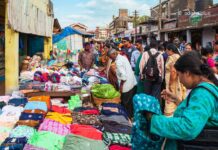Charudutta Panigrahi

“Only a crisis — actual or perceived — produces real change. When that crisis occurs, the actions that are taken depend on the ideas that are lying around.”— Milton Friedman

The apprehension and anxiety are that this virus is going to tamper with one’s DNA and this is going to pass on to generations. Scientists say that about 8% of our DNA comes from viruses. Over a period of time, they would be a part of our DNA and settle down in our constitutions. While this is the effect, the cause is rapid transmission of viruses from animals to humans and this transmission has increased manifold in the last 30-40 years and the viral crossing happens in a cycle of about 3-4 years. So, we run the risk of many more pandemics if this trend continues and if that happens our DNAs are exposed to many and frequent changes. This impact on our genomes might be a long-drawn process, but coronavirus is certainly going to change us. In the years to come, this might make us immune to the sickness but for now, we are in the middle of a life and generation altering assault.

After corona, if this lasts long, we would be rendered homeless, friendless and social less. The social distancing would relegate all of us to our little corners where like zombies we would be engaged in our activities without any human support or partnership. Already the online shopping business, in a week’s time has experienced a rise in business by over 30%. Market places would be virtual, education would be virtual and life would reside inside machines. The only human interfaces would be in the essential zones – health/medical, labour and the like till robots replace them. In the coming decades, humans would have to find alternate ways to keep themselves engaged, at least till one generation, before the total invasion of the machines, AI and the rest. I would not call this as a problem of unemployment but a problem of redefining human role in this planet. By the time Curevac, BioNTech and others come out with a COVID 19 vaccine, if we go at this rate for the next twenty-four months, minimum, there would be a problem of scarce humans left to be vaccinated. The economic system around the world would have come to a grinding halt. On February 28, on a single day, our stock market washed out over Rs 5 lakh crore in investors’ wealth over Novel Coronavirus (nCoV).
Our indices dipped over 3.5 percent, marking the second biggest fall in Sensex history. The markets would boom back intermittently but that wold not be consistent or confident. It is not possible either that all the time rebound in the markets would be aided by hopes that central banks, in India and across the globe will take actions to stabilise financial markets hit by the nCoV wave of crisis. The central banks will not find it easy always to strive to provide ample liquidity and ensure stability in financial markets though they would ensure that all necessary steps are taken to protect financial and monetary stability. What can be done if the economies stop – no economic activities, no trade, no production, no demand, no movement of good and products. The globe would stop – it has stopped for 3 days and we are glaring at a global psychological upheaval. Individuals, families and societies are in doldrums.
In most parts of eastern India, I foresee a reverse migration – people going back to rural areas due to ‘perceived’ less severity of nCOV in villages. Exodus from Cities will increase and at the same time, gainful engagement of the people at the villages would be almost zilch. Some might revive the agricultural land/practices which is about 60 % of the total land area in India. But how can they revive without public financing? Without any movement in the economy, the financing would come to a limping crawl in about 30 months. As the Indian economy continues to slow, now aided by nCOV there would be a debilitating resource crunch in the economy to fund a revival in investments and commercial activity. The domestic funds government and businesses can access for investments is reducing because of the fall in the domestic saving rate in the economy. The decline in the national savings rate is primarily because of a decline in household savings. Within household savings, a sharp fall in actual savings (as in physical savings) of households in recent years has led to the decline in overall savings rate.

No money with individuals and no money with the public and complete seizure of activities – and on top escalating morbidities.
There are talks to introduce a direct cash transfer (universal basic income) to lend, specifically the BPL, the financial support they need to provide for themselves and their families during and after the coronavirus pandemic. Hoping that stage III would leave India not much scathed, the pandemic should taper off in April and if that happens then the low income, daily wage earners would require support for at least a quarter. In three months construction, manufacturing industry, for example, should start rolling, not in full steam though. This is a practical and not an ideological proposal. One can’t look at a budget deficit at this time of devastation, as this might lead the government to spend about Rs 3.2 lakh crores.
After safeguarding people’s health, their personal economic security comes a logical next and we should start the process without delay. Because it would be a humungous exercise across the country requiring alacrity by the state governments too.
The greatest challenge before the governments is to desist the workers who cannot afford to stop attending work to self-isolate and who will continue to go to work and spread the virus, worsening the pandemic – or that those who do follow advice will go bankrupt as a result and be unable to pay their daily ration, food, and rent in slums (primarily for urban poor).

This is the time for farmers to go to the market with their produce and the markets are shut indefinitely. How would the farmer repay his loans? How would the farmer feed his family? The EMIs on the farmers’ loans should be waived off for at least 2-3 installments. There are outstanding not paid to the MNREGA workers and that amount to about 7500 Cr. If not advance, at least the arrears should be cleared for MNREGA work because about 380 lakh households can be immediately benefitted by clearing the payments.
Rajasthan for example has been listed as the highest outstanding state with arrears of Rs 620 Cr and obviously is the state with ‘Negative Net Balance’. The state had demanded Rs 1,950 crore and it has to pay Rs 848 crore as payment of wages and Rs 1102 crore for materials.
The central government’s decision to allow 75 crore beneficiaries to lift their quota of subsidized food grains for six months at a time, is commendable. And what is even better news is the swiftness with which the government decided on this. The government presently supplies 5 kilograms of subsidized food grains per month to each beneficiary under the PDS and this is done with a network of 5,00,000 ration shops across the country. The government incurs about Rs 1.4Lakh Cr annually towards this because food grains are supplied at a subsidized rate of Rs 3/kg for rice, Rs 2/kg for wheat and Rs 1/kg for coarse grains under the National Food Security Act (NFSA). I suggest we should add a soap (bar or liquid) and a hand towel in the PDS basket for the people. This would provide an immediate solution to people in the national drive for behavior change involving handwashing and sanitation.
It is time for My Social Responsibility. We need to help the governments because the pandemic has attacked all of us from multiple flanks.
We are sitting on the Phase III of the pandemic related to the spread of the virus among general population. The health care providers are extremely vulnerable to the infection. There is a shortage of PPE (Personal Protection Equipment) for doctors, paramedics, health care workers in many states. There are no sufficient masks and sanitizers even in the tertiary units or medical colleges, forget about the district and below district facilities. Can you and I look for manufacturers or suppliers who would have stocks of PPEs? All of us with access to internet and working from home we could do this without much difficulty. We could pass the information to health departments. Instead of whiling away time on social media, which has now even started entertaining us on nCOV, we should spend time mining for valuable information, at least from secondary sources. We should also use our contacts to get this information, wherever necessary. It is our primary responsibility to save our live savers, our health care professionals.
I appeal to all alumni networks, social organisations, professional associations, vocational networks, HNWIs to activate volunteerism to create a common pool of resources meant for health care providers. The resources once collected could be handed over to the institution (s) to do whatever is priority.
There are other psychosocial aspects that we need to be braced up with to tackle as an aftermath of this, almost apocalypse (no more a myth).
I am now more concerned about the repercussions and the trail of repercussions about to hit all of us from all quarters.
More in the next part…



























